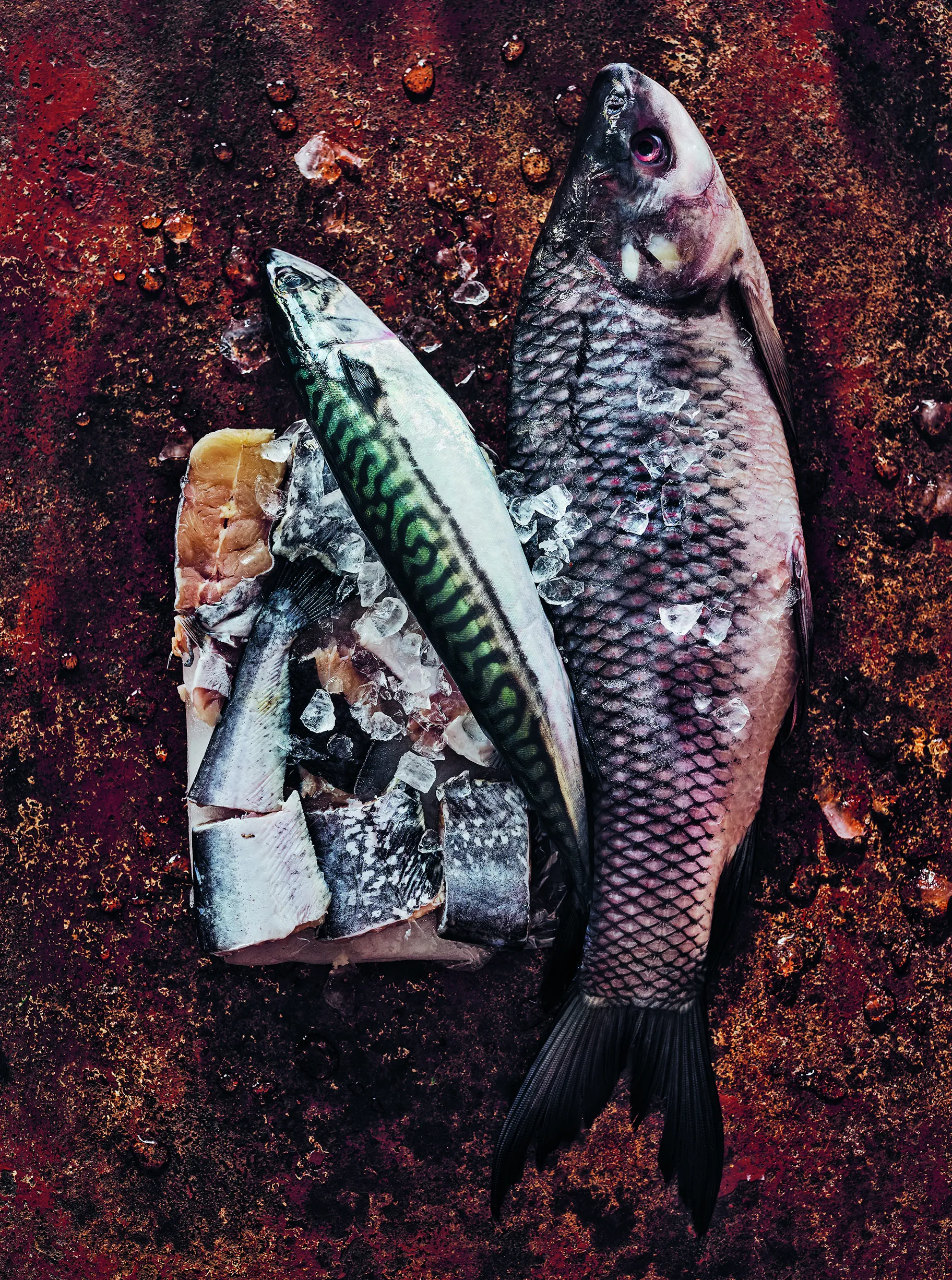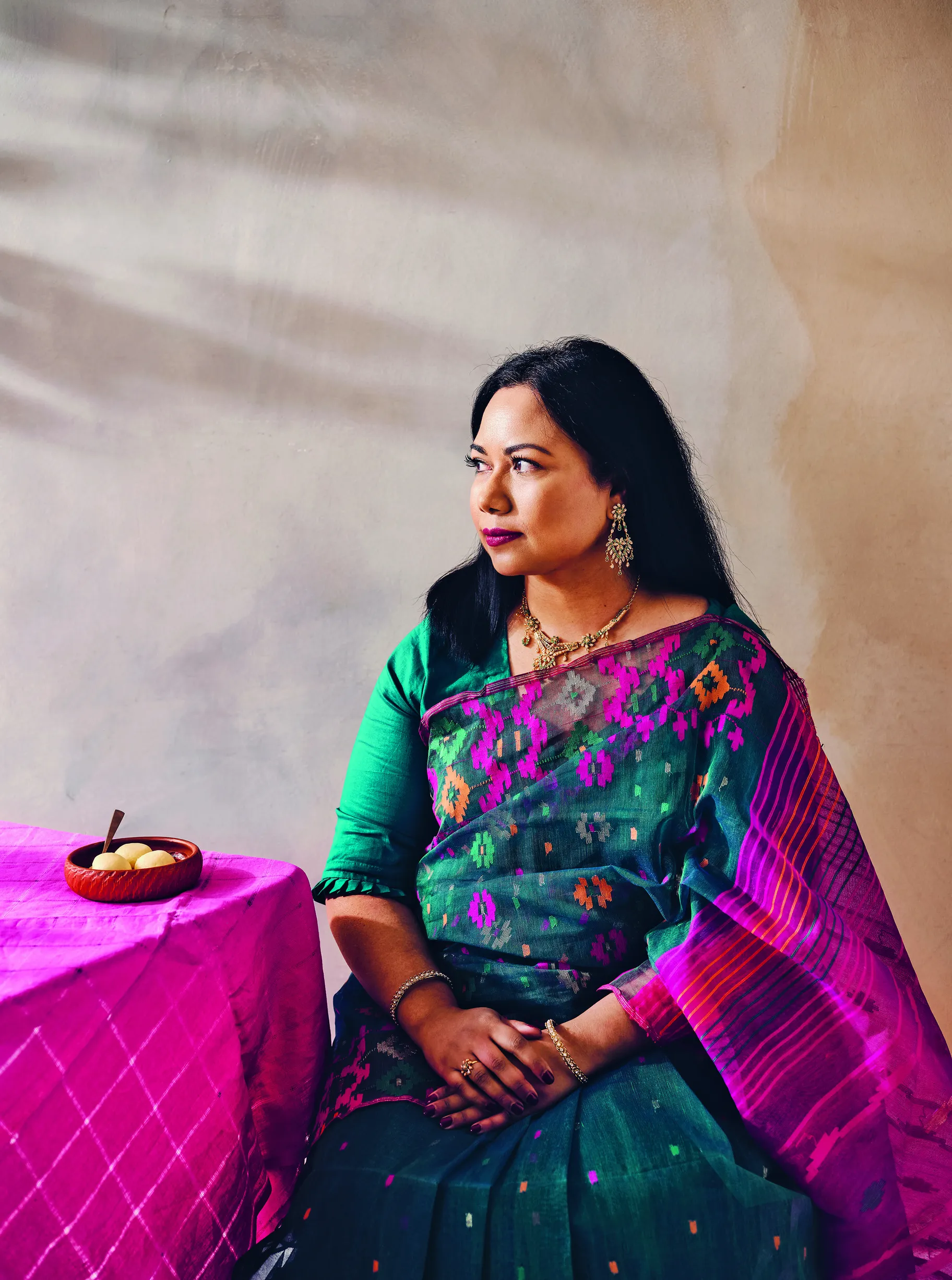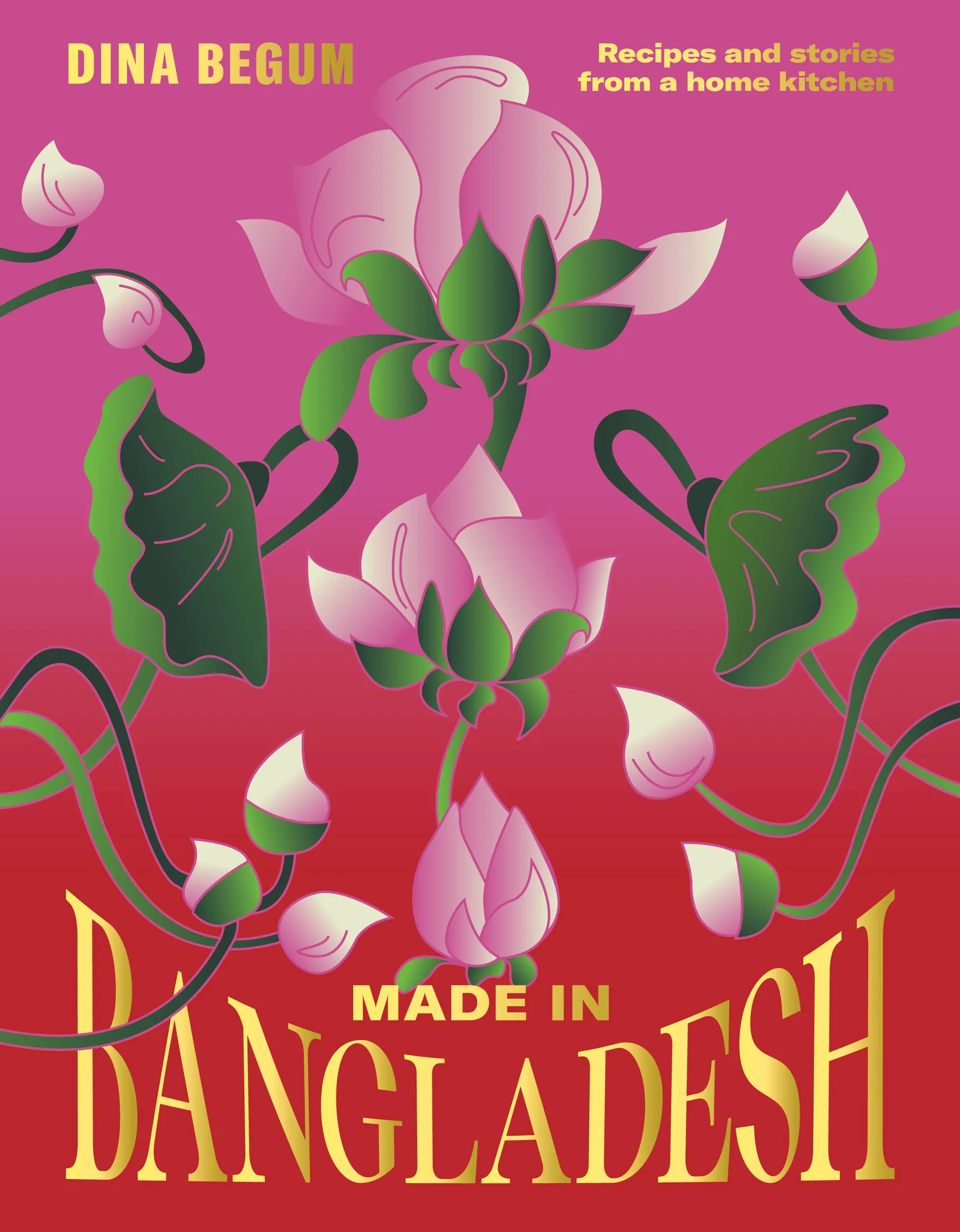Identity is a multi-hued creation involving land, language, customs, and what we cover a lot on this show — food. So when Dina Begum's cookbook, Made in Bangladesh: Recipes and Stories from a Home Kitchen, came out, we were thrilled to get a new look at an identity that is so colorful, complex, and delicious.
Evan Kleiman: Give us a geography and history lesson. Where is Bangladesh? When did it become independent? And what are some of the historical influences related to the cuisine?
Dina Begum: Bangladesh is a fairly new country. It gained independence in 1971. It's at the Bay of Bengal, bordering India and Myanmar (formerly Burma). Before that, it was part of India and briefly, from 1947 to 1971, it was East Pakistan when India was divided. Then, it became Bangladesh in '71. It's a fairly new country but it's always had a very distinct presence in terms of food and culture.
How linked is the food to Bengali cuisine, which is right next door?
There are plenty of overlaps. Bangladesh, when it was India, and then a little bit after, it was Bengal. The whole region, which was West Bengal, is now part of India as well as Bangladesh. It's divided, at the moment, but the language is the same and there are a lot of overlaps in terms of food. In certain parts, especially along Dhaka, which is the capital of Bangladesh, there are more similarities with West Bengal and the Bengali food there. I specifically refer to it as Bangladeshi to make it distinct from Bengali food although you can call it that too.
The food, while we have a lot of similarities in terms of flavors and some dishes, it varies quite a lot. The further south you go down in Bangladesh, especially different regions, each region has a very distinct food culture. For instance, I'm from the region of Sylhet, which is in the Northeast, and that's quite different. You've got lots of fermented and dried fish, chilies, lots of citrus fruits used in broths and stews, and a lot of fish. Fish and rice are the main staples of the country. While there are similarities, I'd say it's very distinct and quite unique from West Bengali food.

Pabda, also known as butterfish, has a central, single bone and sweet flesh. Photo by Haarala Hamilton & Habibul Haque, Drik Picture Library.
Tell us where you grew up in London and what helped form your Bangladeshi identity there.
I've been in London since I was four, so pretty much all my life. I moved when I was very young and we've always had a strong connection to our Bangladeshi heritage, food and culture due to my parents and extended family. Although I didn't visit Bangladesh much, I had that strong connection with relatives visiting us from Bangladesh and those long-distance, 1990s phone calls where everyone was shouting. It was very lively and people were bringing gifts back from visits to Bangladesh. There was always that strong cultural connection with our heritage and we went to Bengali classes, we learnt the language, poetry, and literature.
I've always felt very much connected and I learned to cook from my mother and grandmother. I saw them cooking when I was growing up and then helped them from a very young age. As I grew older, it was very important to me to preserve and highlight those dishes, not just to Bangladeshi people in the diaspora but also to people interested in the cuisine and in Bangladesh as a whole.
You had two main trips to Bangladesh that you wrote about in the book. One was when you were a teen and one was later, as an adult. Can you talk about what each of those trips gave you and what different types of curiosity they sparked for you?
When I was a teenager, I had my first trip back to Bangladesh. That was mainly in our village in Sylhet. I loved that purely for the food focus. We were fed lots of delicious food by our extended family. I saw the produce grown on our farm, the cattle, the fish from the lakes. Everything was pretty much homegrown. We had fresh, delicious dishes cooked every day over a wood fire stove. That piqued an interest in me and I realized the flavors are much different [in Bangladesh] than in the UK even though we had traditional food. There was a lot more variety and the traditional vegetables and ingredients used made a huge difference.
Then, as we grew older, my dad had an allotment or community garden when we moved to a house. He started growing the produce that we saw in Bangladesh — the marrows, pumpkins, leafy greens. That really made me appreciate the importance of fresh produce in Bangladeshi cooking. So when I went back for the research trip for my book, I spent most of my time in Dhaka, the capital, and I hadn't spent much time there. That was a revelation because, as with any capital, people are bringing their regional food to the capital. That was really interesting in terms of eating and solidifying my ideas for the book.
I have two plastic totes filled with spices for making Indian food. What items should I add to it that are more specific to the Bangladeshi kitchen?
One thing, which is also common in West Bengal, if you don't already have it, you should definitely get panch phoron, which is a Bangladeshi or Bengali five spice. It consists of nigella seeds, fennel, cumin, fenugreek and mustard seed. It's a deliciously pungent, aromatic spice blend used at the beginning of cooking in the hot oil. That's used mainly for meat and vegetarian dishes. You should definitely have that.
Mustard seeds alone, either dark or light. Mustard oil, which is very important. There's contention going around [about whether or not] mustard oil is fit for consumption but it's available. You probably see the mustard oil bottles that say "for external use only" but you can consume mustard oil and you can find it in Asian grocery stores, but obviously in moderation you know. Mustard oil is a must because in fish dishes, in particular in bhortas, which are mashes of mainly vegetables or fish or sometimes meat. They're a staple in Bangladeshi cuisine, the bhortas.
So I would definitely suggest mustard oil, panch phoron, and nigella seeds. They're quite good in pastries as well as vegetarian dishes. If you can find a good date molasses from a Bangladeshi store (sometimes Indian stores have it), try and get that as well as some dried fish. Fermented fish is sometimes hard to get unless you're in a very Bangladeshi neighborhood. You can even try dried anchovies, which are quite good for broths and things. And coconut.
They're not spices but I think those are the key ingredients in terms of a Bangladeshi pantry, as well as rice. Definitely you've got lots of varieties of rice — sticky rice, basmati. A lot of my pastries use ground rice and rice flour. Those are two of the pantry essentials, I'd say in terms of flours.
We're talking to you from Santa Monica. We're a citrus area on an ocean, here in California. Tell us more about the marriage of fish and citrus in the cuisine and, in particular, I'm looking at the recipe that is fish with clementine peel.
People might think it's unusual to have peels in a cooked dish but it's very common. You're lucky you're in Santa Monica with all the citrus because if you can't get the traditional ones I reference, you can definitely find clementines. Shatkora, which is specific to the Sylhet region, is a bittersweet citrus and you just use the rinds. It's more of a cooking citrus. You wouldn't eat it on its own. The flesh is quite dry and not very juicy so the peel is usually sliced off and used either dried then rehydrated or fresh, if you have it available. I think it's most popular in the Sylhet region, where I'm from, and other coastal regions of Bangladesh where there's an abundance of fruit and veg.
The citrus adds a freshness to fish stews. I would say they're more broth-like, light stews rather than curries, which are richer, so you wouldn't add much oil to those dishes. It's definitely a summertime dish. When the weather is milder, you have those dishes and they're really nice with plain rice. It's a perfect combination. You've got the clementine peel, which is one of the classic ones, with the papeda. Then there's shatkora, which you can also use in fish. That is the bittersweet one I mentioned, and that's a stronger flavor whereas the clementine peel adds a gentler aroma to the dish.
And if we can't find shatkora, can we substitute pomelo?
Pomelo is a good substitute or try and use a mixture of grapefruit peel and lime peel. Try and use a bitter citrus with a sweet citrus to give that bittersweet aroma of shatkora

Dina Begum has lived in London since she was four years old. Two trips to Bangladesh sparked her curiosity about its ingredients. Photo by Haarala Hamilton & Habibul Haque, Drik Picture Library.
You have several menus that you've created at the front of the book, which I love. I always like to see examples of how to put dishes together. One, in particular, really leapt out at me and that was the afternoon tea. Can you talk about some of the dishes that you would serve at a Bangladeshi tea in the afternoon?
Tea is an institution in Bangladeshi culture. You have tea any time of day. It could be morning tea, afternoon tea, or evening tea. They range from small, where you can have a cup of tea or cha, as we call it, with a sweet or savory item or both. Or you can have a selection of dishes. So a common tea time snack would be shingara, which is like a samosa. It's pyramid-shaped and made with handmade pastry. It's got a potato filling with the panch phoron, the spice blend that I talked about earlier. That's a really aromatic, spicy potato filling. It's crispy and fried, and most people love crispy, fried food so that's a great addition to livening up your afternoon.
You might also have nimki, which are fried pastry bites with nigella seeds. That's commonly eaten during cha nasta as well as a halwa. I've got a tusha shinni in there, which is a flour halwa with spices and raisins. That's quite nice to have. Or you have various pithas, which are rice-based sweets or savories. One of my favorites, the patishapta, which is a rice crepe filled with a rice cream with saffron and cardamom. These are some of the classic afternoon tea dishes you'd have with your chai.
Also, the baked sweet yogurt. There's something about it. It looks so simple but I can tell that it's something absolutely delicious.
I would say that's one of my all-time favorites and that's definitely a classic Bangladeshi or Bengali dish. It's got a distinct burnt caramel flavor. The base of it is basically milk, cooked down with the addition of yogurt to help it set. It's got a caramelized sugar in there to give that kind of earthy, burnt taste to it. When it's baked, when I get it right, it's almost like a cheesecake texture or consistency. It's super delicious at the end of the meal. It's light enough but also quite rich. What can I compare it to? Maybe a crème brûlée. It's similarly quite light but also thicker in texture. It's a classic in Bangladeshi meals and that's usually eaten at the end of the meal or you can also have that for afternoon tea.
That pairs quite well with rasgulla, which are round cheese dumplings soaked in syrup. That's a good pairing if you have mishti doi as well as rasgulla, which I have a recipe for in the book. It's such a simple dessert but it has so much flavor.
The rasgulla are dangerously delicious.
Yes, absolutely. You need tons of them, especially when they're warm.
Komolar Khosha Diye Pabda
Fish with clementine peel
Serves 4
Sylhetis love light fish curries and stews with either citrus or sour flavours, and I grew
up with this classic sweet and tart dish. Pabda is a delicacy in Bangladesh, and is among the favoured group of fish. Outside of Bangladesh, it is widely available from the freezer section of Bangladeshi grocery stores, usually in blocks of 6–8 fish. They have a single central bone and delicate, sweet flesh. I would encourage you to seek some out if you live near a Bangladeshi neighbourhood, or order online from a few stores who deliver. In lieu of this, I’d recommend skin-on sea bass fillets as a good alternative. Serve with basmati rice.
Ingredients
- 1 block whole pabda (around 430 g/15 oz once defrosted), or 4 skin-on sea bass fillets
- 4 tablespoons vegetable oil
- 4 garlic cloves, grated
- 1 medium onion, finely sliced
- 11⁄4 teaspoons salt
- 200 ml (7 fl oz/scant 1 cup) water
- 21⁄2 teaspoons chilli powder
- 2 teaspoons ground coriander
- 3⁄4 teaspoon ground turmeric
- 25 g (1 oz) clementine peel, cut into roughly 1 cm (1⁄2 in) pieces
- 250 ml (8 fl oz/1 cup) boiling water
- 4 green chillies, split lengthways (keep them whole if you prefer less heat)
- small handful of coriander (cilantro), chopped
Instructions
-
Heat the oil in a wide, deep frying pan over a medium–high heat for about a minute, then add the garlic. Cook for around a minute, until golden, then add the onion and salt. Sauté for 2–3 minutes until softened and light golden. Add 100 ml (31⁄2 fl oz/scant 1⁄2 cup) of the water, then reduce the heat to low and cover. Cook for 5 minutes, then remove the lid and gently mash with a potato masher. Stir until the oil has risen to the surface. Add the ground spices and cook out for 2 minutes, then add the remaining 100 ml (31⁄2 fl oz/scant 1⁄2 cup) water. Cover and cook for another 2–3 minutes, then stir in the clementine peel. Cover once more and cook a further 4–5 minutes, stirring once halfway through.
-
Add the fish and carefully and quickly stir through so that the spice mixture evenly coats the fish. Ensure the fish pieces are lying flat in the pan; this is the only time you will be able to mix the delicate fish. Increase the heat to low–medium and cover. Cook for 6–7 minutes, shaking the pan very gently if you feel the fish may be catching.
-
Add the boiling water to the pan, pouring it in around the sides and being careful not to break the fish. Increase the heat to medium–high and bring to a simmer. Cook for
5–6 minutes, then add the chillies and coriander and gently swirl the pan – remember not to stir. Cook for a final 2 minutes, then take off the heat and serve.

"Made in Bangladesh" highlights a flavorful cuisine from a young country. Photo courtesy of Hardie Grant.
